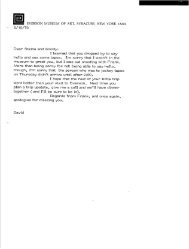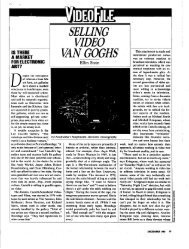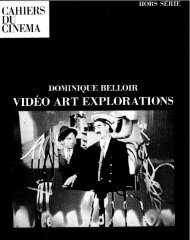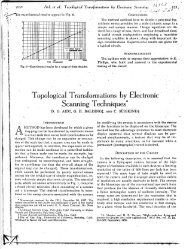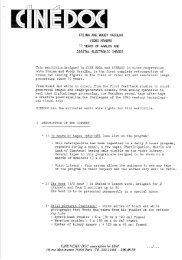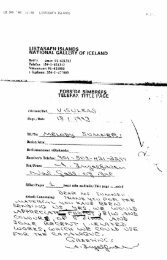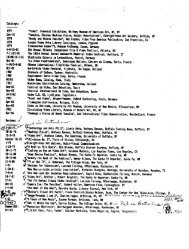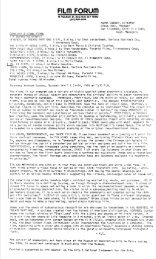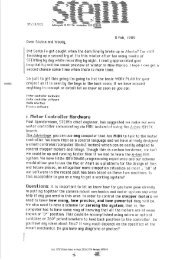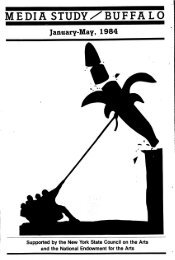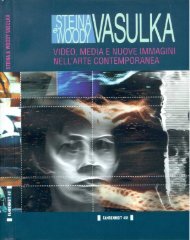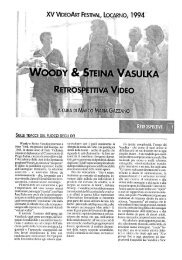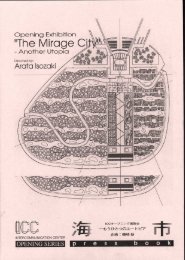Chapter 4: A HISTORY OF COMPUTER ANIMATION ... - Vasulka.org
Chapter 4: A HISTORY OF COMPUTER ANIMATION ... - Vasulka.org
Chapter 4: A HISTORY OF COMPUTER ANIMATION ... - Vasulka.org
You also want an ePaper? Increase the reach of your titles
YUMPU automatically turns print PDFs into web optimized ePapers that Google loves.
<strong>Chapter</strong> 4 : A <strong>HISTORY</strong> <strong>OF</strong> <strong>COMPUTER</strong> <strong>ANIMATION</strong> 3/20/92 2 6<br />
Whether or not the machinery is computer controlled, slit-scans<br />
require that a scripted, notational plan be prepared in advance of<br />
shooting . Equally algorithmic was the work of Canadian pioneer<br />
Norman McLaren, who employed the strobe, a multiple pass optical<br />
technique, in the short film Pas de Deux (1969) . [to chronology or<br />
loose as did the Australians Arthur and Corria Cantrill, who<br />
employed it in color in the films Heat Shimmer and Waterfall (date<br />
??) .] On an animation stand a strobe is made by multiple exposures<br />
of static artwork with the camera moved closer (or further away)<br />
from the artwork, and it is similar to a streak, which is made with<br />
the camera zooming with the shutter open (fig . 54) .<br />
but an ability to think about the process more strategicly .<br />
(Illustration courtesy Dick Rauh .)<br />
54 . Streaks and strobes . A strobe and a streak are similar except<br />
a strobe is discrete and a streak is continuous . A streak effect is<br />
achieved by leaving the camera shutter open while the artwork (or<br />
camera) is in movement . A strobe effect is achived by moving the<br />
artwork (or camera) and making multiple exposures on a single<br />
frame of film . The critical difference between a streak and a slit<br />
scan is that there is no moving slit in the streak (or strobe) process .<br />
A streak animates by changing initial and terminal artwork (or<br />
camera) positions on a frame by frame basis . In the illustration the<br />
word SALE is streaked progressively longer distances from frames 1<br />
to 10--the starting position is held constant in an initial position<br />
just below the frame, and on each successive frame the leading edge<br />
of the streak, or the head, is streaked progressively further from the<br />
initial position . The action is that the word SALE animates up into<br />
position in 10 frames (A) . The apparent 3D curve is simply an<br />
artifact of the camera move . To collapse the tail of the streak, say<br />
from frames 10 to 15, the ending point of the streak is held static,<br />
but the starting point of the streak is animated upward, so that the<br />
tails gets progressively shorter until only the word SALE remains on<br />
the screen . Diagram B shows the distance of camera travel for each<br />
frame ; Diagram C is layout notation for the same effect .<br />
A strobe animates much the same way as a streak, only instead<br />
of moving the artwork (or camera) with the shutter open during the<br />
frame, the artwork (or camera) is moved in a series of discrete<br />
steps and shot with multiple exposures on a single frame (G and H) .<br />
A strobe of live action footage is achieved by rephotographing the<br />
original action as a series of multiple exposures, while changing the<br />
sync in the temporal domain (I and J) . The effect is that the live<br />
action movement appears to expand and contract . In order for the



